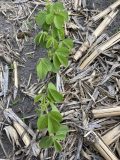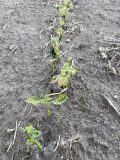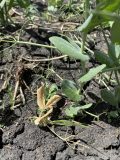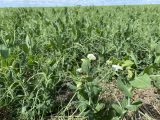June 23, 2021
- Crop Update
- Scouting Notes
- Fungicide Decisions in Field Peas
- Pea and Faba Bean Nodule Assessment
- Scouting for Pea Aphids
- Post-Emergent Soybean Rolling
- Iron Deficiency Chlorosis (IDC) in Soybeans
- On-Farm Network Investigates: Next-Level Nitrate
- Looking for a printed copy of our fact sheets?
Listen to The Bean Report:
Crop Staging
- Soybeans range from V1 to V4 and will be starting to flower soon with the change in day length. IDC symptoms have started to show up in some fields, but most fields remain symptom-free.
- Dry beans range from the unifoliate to the third trifoliate stage (VC to V3).
- Field peas range from 8 to 12 true nodes with some at R1 (flower bud) with a few open blooms scattered throughout the field. As pea flowering advances this week, start looking for Mycosphaerella blight in the lower canopy.
- Faba beans range from R1 (flower bud) to R2 (beginning bloom), with about 8 to 9 leaf nodes. For both peas and faba beans, flowering is the best time to check nodulation and to start looking for pea aphids.
Scouting Update
- Southern areas of the province received strong winds that damaged some soybean and dry bean crops, resulting in leaf tearing and stem breakage, which are now re-growing from the axillary buds. In these fields, expect some bacterial blight to infect those damaged plants. At low severity levels, this isn’t typically a yield-limiting disease. Bacterial blight has also set into peas and symptoms can be easily confused with Mycosphaerella blight. Accurate identification is important when you’re making fungicide decisions, since bacterial blight will not be controlled by fungicide.
- Grasshopper nymphs have been feeding at field edges. At vegetative stages the threshold for control in soybeans is greater than 30% defoliation and for dry beans is 35% defoliation. Research from Ontario has also indicated that soybeans can tolerate up to 50% defoliation at early V-stages. Border or edge sprays at these stages are often enough for control.
- Late season weed scouting – evaluate the effectiveness and weaknesses of this year’s weed control program, and plan for next year’s program by identifying weeds to target.
Not sure which critters you should be looking for in pulse and soybean crops right now? Check out our full suite of Insect and Disease Scouting Calendars for soybeans, dry beans, field peas and faba beans.
Fungicide Decisions in Field Peas
 Mycosphaerella (Ascochyta) blight is the main target of fungicides in field peas. From ten nodes (V10) to early flower (R2), scout for symptoms. Early symptoms commonly show up as small dark freckles on lower leaves during late June/early July.
Mycosphaerella (Ascochyta) blight is the main target of fungicides in field peas. From ten nodes (V10) to early flower (R2), scout for symptoms. Early symptoms commonly show up as small dark freckles on lower leaves during late June/early July.
Foliar fungicide applications are typically made at R2, when one flower is open on most plants across the field. But in drier years, it may be beneficial to delay application. There is a fungicide decision worksheet available to determine if a fungicide application is likely to be beneficial. Things to consider include density of the crop canopy, leaf wetness and humidity, the 5-day forecast and how many plants are symptomatic.
If a score is below 65, or above 65 but disease is not yet present, revisit the field in a few days and reassess. If the field is scoring above 65 but disease is not present, conditions are suitable for disease to develop and the field should be revisited in a few days to catch any developing symptoms early.
Continue to monitor for Mycosphaerella and its progression up the pea canopy from early bloom (R2) to full pod (R4) to determine if a second application may be warranted.
Pea and Faba Bean Nodule Assessment
Field pea and faba bean root nodules can form as early as 2 weeks after emergence, but the best time to assess nodules is at the 6-9th node to R1 stages, to capture peak nodulation.
- Dig out the root system of 5-10 plants from 2-3 representative areas of the field.
- Soak roots in water if dealing with clay soils that may strip off nodules.
- Follow the nodule scorecard below, rating plant growth and vigour, nodule colour and number, and nodule position. Cut nodules open to assess the colour. If they are pinkish-red inside, that means they are actively fixing N. Brown, white or green nodules are considered inactive.
- Check the nodules on a few extra plants if you are finding wide variation across the field.
- If your field scores less than 6, further investigation is required to determine if a rescue N treatment is needed.
Notes on Rescue Nitrogen in 2021:
Rescue application in peas has not been well researched. If you have checked nodulation, found it to be insufficient, there are signs of N deficiency (yellowing of the lower leaves) and yield potential of the crop is good, then consider a rescue nitrogen application.
- Peas remove 2.3 lbs N/bu in the seed, so additional N may be required for pod fill. We suggest applying 40-50 lbs/ac of granular N at the 9-12 node stage before flowering so nitrogen is available for pod fill, and for ease of getting the application through the crop canopy.
- Apply as a granular form to avoid leaf scorch from liquid applications and apply so the granules fall through the pea canopy to the soil surface.
- Rain is necessary to move nitrogen into the soil – if applied without rain in the forecast consider using a urease inhibitor.
This year, the On-Farm Network is investigating high nitrate levels across Manitoba in fields where fall soil tests indicated low to moderate N levels. Read the update below for information on this investigation.
Scouting for Pea Aphids
- Start searching for pea aphids in field pea and faba bean crops from late June to early July, when 50-75% of the crop is in early flower.
- Check five plant tips (top 8 inches) or conduct 10 sweeps using a sweep net, at four different locations in the field. Note that pea aphid pressure may be greater near field edges. If you are inspecting plant tips, unfold the clam leaf (newest stipule) to check inside for aphids.
- The threshold is 2-3 aphids/plant tip or 90-120 aphids/10 sweeps (or 9-12 aphids per single sweep). If the threshold is reached, apply a registered foliar insecticide at early pod (when 50% of plants have produced young pods).
- Before applying insecticide, consider the presence of natural enemies including lady beetle adults and larvae, hoverfly larvae, minute pirate bugs, damsel bugs, parasitic wasps and fungal diseases that can all help reduce the aphid population.

Post-Emergent Soybean Rolling
If you are considering rolling your soybeans post-emergence, the best time is at the V1 stage when all plants have grown past the hook stage and have not yet reached V3 – both of which elevate your risk of breakage. With the recent heat and past rains, soybean development may surprise you, so don’t delay checking those fields for rolling timing. Some soybean crops are reaching or have surpassed the V3 stage in the eastern and central regions.
If you decide to roll, target some nice hot weather (25°C+) and the hottest part of the day, travel with the rows (not perpendicular), check for breakage as you go and ensure the benefits outweigh the losses.
Iron Deficiency Chlorosis in Soybeans
Iron deficiency chlorosis (IDC) symptoms are starting to show up in soybeans. IDC appears as interveinal yellowing (chlorosis) of plant tissue as young as the first trifoliate leaf. Conditions that lead to IDC include excess calcium carbonates, soil moisture, soluble salts and/or high nitrate levels that can all impede iron (Fe) uptake into the plant. It is often a temporary condition that resolves itself. If symptoms dissipate by the V5-V6 stages, yield loss will be minimal.
There isn’t much you can do about IDC in-season, so the main focus right now is identification and record keeping of severity in each field. The best method for control is prevention, starting with variety selection. In fields that are prone to IDC, tolerant varieties are the number one control method for this condition. Other options for control include improved drainage, heavier seeding rates, practices that reduce soil N levels and in-furrow iron chelate products.
Research has been underway in Manitoba, looking at the relationship between IDC score and soybean yield of Manitoba-grown varieties, led by Kristen P. MacMillan (Soybean and Pulse Agronomy Lab, University of Manitoba). Results have shown that for each 0.1 unit increase in IDC score, soybean yield is estimated to be reduced by 2.4-2.8 bu/ac, on average.

For more on the latest Manitoba-based IDC information, check out the Soybean and Pulse Agronomy Lab 2019-2020 Annual Report or the article, Yield Impact of Yellow Soybeans and Management Strategies.
On-Farm Network Investigates: Next-Level Nitrate
Every spring, as certain trials are established, the OFN collects routine site composite soil samples. Usually, this simply serves as background information to inform our understanding of yield potential and crop performance through the season. This spring though, we were in for a surprise. A number of spring soil test results indicated unusually high, and seemingly inexplicable levels of nitrate in the top two feet. Out of soil test data for 33 fields, more than half came back with nitrate levels in the high to very high category. The question is, why?
In addition to our usual suite of trials, the OFN team is investigating this phenomenon, tracking nitrate in the top two feet over the course of the growing season at 15 fields, digging into field history and other possible explanations like the Birch effect – a biological phenomenon that could explain a large flush of nitrate by soil rewetting, following a prolonged dry period.
Stay tuned for updates! Contact Megan at 204-751-0439 or megan@manitobapulse.ca if you have any questions.
Looking for a printed copy of our fact sheets?
The absence of in-person events has limited our ability to distribute printed copies of our fact sheets to agronomists and industry representatives. Take a look at our catalogue of resources to see if there is one (or a few) resources that you would like a laminated hard copy of to carry with you or a few copies to share with others. Contact Cassandra or Laura to arrange a mail-out, drop-off or pick-up.
LIST OF MPSG RESOURCES
Soybeans
- Production Guidelines
- Fertility Factsheet
- Seed Treatment Risk Assessment
- Growth Staging and Maturity Guide
- Plant Development Guide
- Insect and Disease Scouting Calendar and Identification Guide
- Soybean Aphids: Identification, Scouting and Management
Field Peas
- Production Guidelines
- New! Organic Production Guidelines
- Growth Staging and Maturity Guide
- Insect and Disease Scouting Calendar
- Root Rot in Peas and Lentils
- New! Fungicide Decision Worksheet for Mycosphaerella Blight
- New! Desiccation and Harvest Guide
Dry Beans
- Growth Staging and Maturity Guide
- Insect and Disease Scouting Calendar
- Fungicide Decision Worksheet for White Mould
- New! Desiccation and Harvest Guide





























